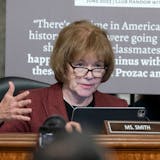Live in a city long enough, and its geographic lingo becomes second nature.
Amy O'Meara, for example, has lived in "Lyn-Lake," an abbreviation for Lyndale Avenue and Lake Street. She also resided in the North Loop, coined after an old Minneapolis streetcar line. And then there was Uptown.
"It all makes sense, except Uptown," O'Meara said of the commercial area that is — bafflingly — south of downtown. O'Meara asked the Star Tribune to look into the name for Curious Minnesota, a community-driven reporting project fueled by great questions from inquisitive readers.
"Uptown" is common parlance today for the district around Hennepin Avenue and Lake Street, but that is a relatively recent phenomenon. For much of the 20th century, the area was commonly known as "Hennepin-Lake," despite efforts to push the Uptown moniker.
A century ago, in fact, Uptown appears to have referred to a very different part of Minneapolis — downtown. Newspaper clippings from the 1920s include Uptown references, meaning the central core area further from the Mississippi River, past 7th Street.
But modern day Uptown really staked its claim in 1929 when one of the area's most prominent attractions, then the Lagoon Theater, was renamed the Uptown Theatre.
"The name 'Uptown' was chosen to conform with a movement now in progress to establish the Lake and Hennepin community as 'The Uptown District of Minneapolis,' fashioned after the famous and prosperous district of that name in Chicago," the Minneapolis Star reported at the time.
By 1950 there were a number of businesses sporting the "Uptown" handle, based on research conducted by Thatcher Imboden, who co-wrote the 2004 history of the area, "Uptown Minneapolis." But the name still hadn't quite reached the mainstream.


